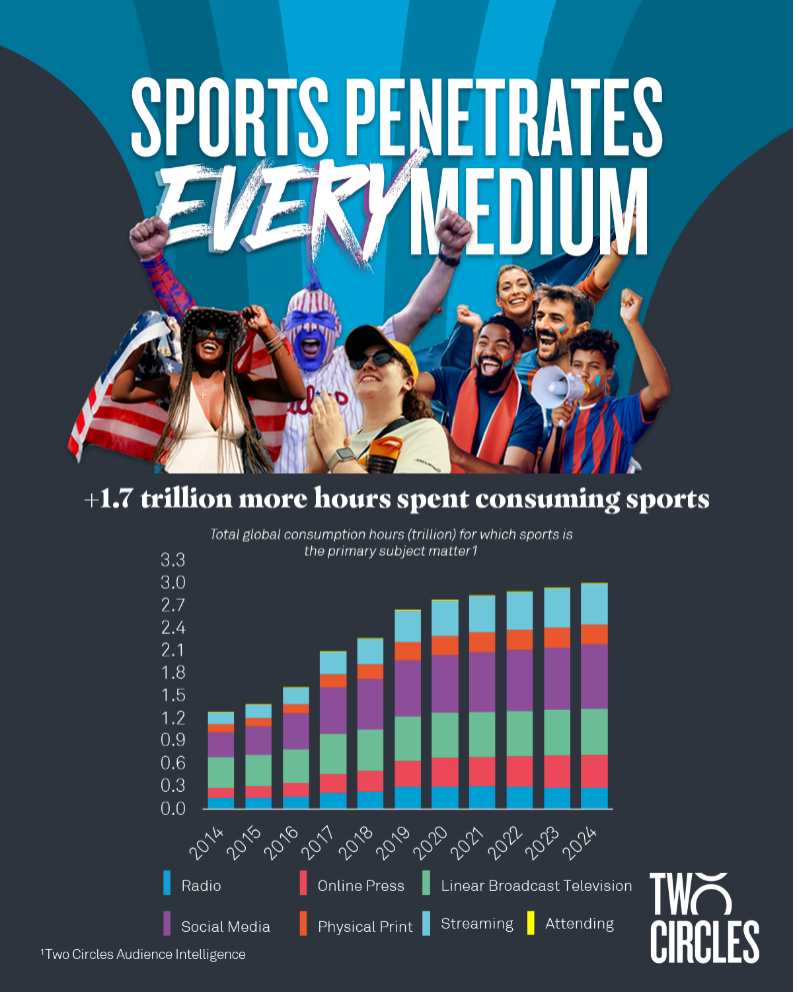250 billion Reasons Why Brands Are Backing Sports
21 July 2025
Sport is booming — with fans spending over three trillion hours watching in 2024 and $250bn invested by brands. But sponsorship isn’t keeping pace. Two Circles explores the “objectives divide” holding it back — and how smarter, more aligned strategies could unlock a $30bn opportunity.
Sport is commanding more attention than ever. In 2024, fans spent over three trillion hours consuming professional sport – and that figure is only growing. With $250bn invested in sport through sponsorship and media last year, brands are clearly taking notice.
But there’s still a major opportunity. A decade ago, 29% of brand spend targeting sports audiences went to sponsorship; today, it’s just 19%. Our data shows that brands who strike a better balance between media and sponsorship see stronger alignment with fan behaviour, greater cultural relevance, and more long-term impact. We expect a $30bn shift from media into smarter sponsorship.
So what’s holding sponsorship back? A disconnect between brands and rights holders, what we call the ‘objectives divide’. 63% of brands say properties don’t understand their goals, and 75% of rights holders say the same about brands. The brands closing that gap by embedding intelligence across their sponsorship strategy they will unlock the greatest returns.
As we mentioned sports is thriving, Fans are spending over 3 trillion hours with sports each year. This is set to rise to 4 trillion by 2034. Audiences are watching everywhere, on commutes, between meetings, while multitasking. Sport is cutting through this, it continues to command a bigger, broader, more engaged audience than ever before. Creating moments that matter, and brands are taking notice.

In 2024, brand investment in sport hit a total of $250 billion. It’s the biggest number we’ve seen yet and sponsorship is now happening at every level. While there’s been growth in high-profile, $20M+ partnerships, we’re also seeing a real rise in $1M-level deals. That’s significant. It shows how the space is opening up, sponsorship is no longer limited to a handful of big players. It’s becoming more accessible, more active, and more flexible across a broader range of budgets.
This shift is being driven by a surge in new rights and assets, the emergence of new talent, new teams and competitions entering the market, and the expansion of existing properties. There are simply more opportunities for brands to get involved.
And they are. In 2024 alone, more than 5,000 brands signed sponsorship deals worth over $1 million, and the average deal size has risen from $0.8M in 2019 to $1.0M today. Brands are entering the space and increasing their investment.
But despite this growth, there’s a challenge. Media spend is growing faster. Brand investment in digital media, particularly to reach sports audiences, is outpacing sponsorship, even though sponsorship itself is growing by $20B year-on-year. This shift often comes at the expense of long-term sponsorship – in part because digital media offers easily measurable metrics, from impressions to click-through rates. Sponsorship, by comparison, can feel harder to quantify. But that doesn’t make it less valuable. In fact, the strongest sponsorships go beyond visibility; they build emotional connection, cultural relevance and long-term brand affinity that media alone can’t achieve.
And a big reason for that? Misalignment. For many brands, the biggest barrier to unlocking sponsorship’s full potential is a disconnect between objectives. In fact, 63% of brands say their property partners don’t fully understand their goals, while 75% of properties say brand objectives are unclear. It’s no wonder sponsorships sometimes underdeliver – not because the potential isn’t there, but because they’re not being measured against what matters most. In many cases, brands aren’t even sure what they’re measuring. That leads to missed cross-funnel impact, and an overdependence on media to fill the gap.
The fix? Better understanding, and better intelligence. It starts with alignment, setting shared KPIs from the start. It means actively managing sponsorship portfolios, and measuring return-on-objective in ways that reflect the true impact of sport. With the right structure, sponsorship can stop being a static badge and start becoming a genuine growth engine.
It’s a bit like getting the balance right between diet and exercise. Digital media gives you the short-term boost, the “diet” but it’s sponsorship that builds the long-term strength. That’s the “exercise.” And just like with any healthy lifestyle, brands need both.
Those who win in this space won’t just be the ones spending the most. They’ll be the ones who bring intelligence to every stage of the process , and strike the right balance between sponsorship and media to unlock real, long-term value.
Please see here to read the full report: https://twocircles.com/gb/articles/250b-reasons-why-brands-are-backing-sports/

